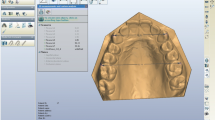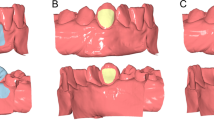Summary
A 3-D photographic technique was developed for the registration of bite conditions. This technique may replace plaster models for archiving purposes. To achieve this, photographic equipment and computer programs should be user friendly, not too expensive, and allow measurements that satisfy scientific demands. This purpose was fulfilled by combining the following elements: a photographic unit with standardized conditions for 3-D photography and a reference object with known coordinates where bite impressions or models are placed during photography. To reconstruct 3-D coordinates from photographs these are placed on a digitizer connected to a computer programmed for reconstructing 3-D coordinates from the digitized 2-D data. The accuracy of the 3-D reconstruction of coordinates, x, y, z, was tested by means of 3-D photographs of a test object with reference points having a precision of ±0.5 μm. The mean error for distances of 5 mm and 15 mm varied between −0.17 mm and +0.15 mm. Measurements of 45° and 90° angles had an accuracy that varied from −0.5° to +0.9° and from −1.2° to +1.5° respectively. An angle between lines and a plane of 54.7° displayed a mean error of ±1.6°. The test of the accuracy of the 3-D photographic technique for calculating distances and angles demonstrated that it fulfills demands for scientific applications on clinical material.
Zusammenfassung
Eine dreidimensionale fotografische Technik für die Registrierung von Bißverhältnissen wurde entwickelt. Diese Technik sollte in einem gewissen Ausmaß Gipsmodelle für Archivierungszwecke erssetzen. Die fotografische Ausrüstung sollte benutzerfreundlich und nicht zu teuer sein und Messungen erlauben, die wissenschaftliche Ansprüche zufriedenstellt. Dieser Zweck wurde erfüllt, indem folgende Bestandteile kombiniert wurden: eine fotografische Einheit mit standardisierten Verhältnissen für das 3D-Fotografieren und ein Referenzobjekt mit bekannten Koordinaten, auf dem während des Fotografiervorgang ein Abdruck oder das Modell eines Bisses plaziert wurde. Um 3D-Koordinaten von Fotografien zu rekonstruieren, wurden diese auf einen Digitalisierer gelegt, der an einen Computer mit einem Program für die Rekonstruktion von 3D-Koordinaten aus digitalisierten zweidimensionalen Daten angeschlossen war. Die Genauigkeit der x-, y- und z-Koordinaten aus der 3D-Rekonstruktion wurde mit Hilfe von 3D-Fotografien eines Testobjektes mit Referenzspunkten getestet, die eine Genauigkeit von ±0.5 μm besaßen. Die mittlere Fehlerquote für Abstände von 5 bis 15 mm variierte zwischen −0,17 mm und +0,15 mm. Messungen von 45°-und 90°-Winkeln hatten eine Genauigkeit, die zwischen −0.5° und +0,9°, bzw. −1,2° und +1,5° variierte. Ein Winkel zwischen einer Linie und einer Ebene von 54,7° wies eine mittlere Fehlerquote von ±1,6° auf. Ein Genauigkeitstest der dreidimensionalen Technik für die Abstands- und Winkelberechnung zeigte, daß sie den Anforderungen an die wissenschaftliche Verwendung klinischen Materials genügte.
Similar content being viewed by others
References
Ang S. A method for relating dental casts to lateral skull radiographs. Msc, University of London, 1978.
Arridge SR, Moss JP, Linney AD. Three-dimensional digitization of the face and skull. J Maxillofac Surg 1985;13:136–43.
Baumrind S, Moffit FH, Curry S. Three-dimensional X-ray stereometry from paired coplanar images: a progress report. Am J Orthodont 1983;84:292–312.
Berkowitz S, Krischer J, Pruzansky S. Quantitative analysis of cleft palate casts. Cleft Palate J 1974;11:134–61.
Berkowitz S, Pruzansky S. Stereophotogrammetry of serial casts of cleft palate. Angle Orthod 1968;38:136–40.
Fuhrmann R, Feifel H, Schnappauf A, Diedrich P. Integration of three-dimensional cephalometry and 3D-skulls models in combined orthodontic/surgical treatment planning. J Orofac Orthop/Fortschr Kieferorthop 1996;57:32–45.
Hagberg C. The alignment of permanent mandibular incisors in children. A longitudinal prospectice study. Eur J Orthod 1994;16:121–9.
Howe RP, Scholz RP. A coordinate system for model storge. J Clin Orthod 1985;19:640–5.
Karara HM. Non-topographic photogrammetry, 2nd edn. American Society for Photogrammetry and Remote Sensing. Edwards Brothers Inc., Bethesda, Maryland, USA 1989.
Keating PJ, Parker RA, Keane D, Wright L. The holographic storage of study models. Br J Orthod 1984;11:119–25.
Mansbach M. Die Stereophotogrammetrie als Hilfsmittel in der Orthodontie. Z Zahnärztl Orthop 1922;4:106.
Mårtensson B, Rydén H. The holodent system, a new technique for measurement and storage of dental casts. Am J Orthod Dentofac Orthop 1992;102:113–90.
Scott PJ. The reflex plotters: measurement without photographs. Photogrammetric Record 1981;10:435–46.
Author information
Authors and Affiliations
Rights and permissions
About this article
Cite this article
Lindqvist, B., Welander, U. & Mähler, R. A three-dimensional photographic method for documentation and measurement of dental conditions. J Orofac Orthop/Fortschr Kieferorthop 59, 90–99 (1998). https://doi.org/10.1007/BF01340643
Received:
Accepted:
Issue Date:
DOI: https://doi.org/10.1007/BF01340643




